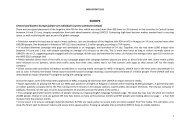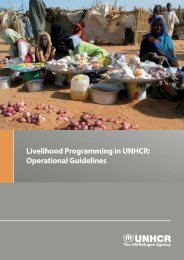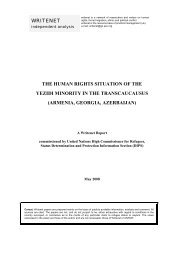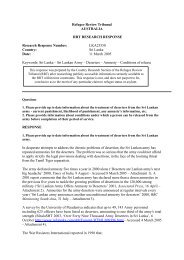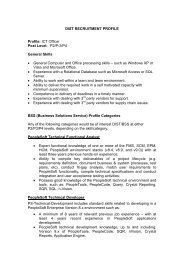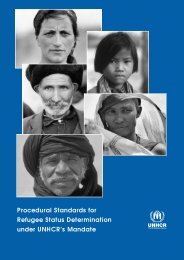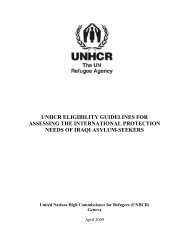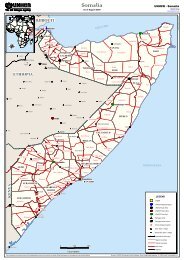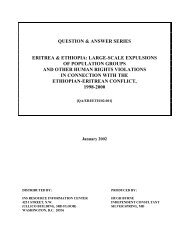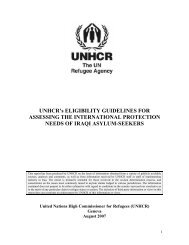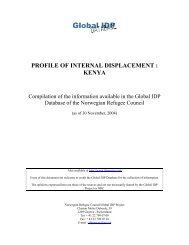CONCLUSIONS ADOPTED BY THE EXECUTIVE ... - UNHCR
CONCLUSIONS ADOPTED BY THE EXECUTIVE ... - UNHCR
CONCLUSIONS ADOPTED BY THE EXECUTIVE ... - UNHCR
Create successful ePaper yourself
Turn your PDF publications into a flip-book with our unique Google optimized e-Paper software.
2007 (Executive Committee—58 th Session)<br />
ii. States should promote the establishment and implementation of child protection systems, in accordance<br />
with international obligations of States concerned, and to which children under their jurisdiction should<br />
have non-discriminatory access;<br />
iii. The support provided by <strong>UNHCR</strong> and other relevant agencies and partners in helping States fulfil their<br />
obligations should supplement and strengthen the national child protection system in areas where gaps<br />
exist, and be delivered in a spirit of partnership by building on each actor's comparative advantages to<br />
reinforce the beneficial impact on the protection of children;<br />
iv. States, <strong>UNHCR</strong>, and other relevant agencies and partners shall assure to the child who is capable of<br />
forming his or her own views the right to express those views freely in all matters affecting the child,<br />
the views of the child being given due weight in accordance with the age and maturity of the child, and<br />
that mechanisms exist to inform children and adults alike of children's rights and options;<br />
v. The principle of the best interests of the child shall be a primary consideration in regard to all actions<br />
concerning children;<br />
vi. Due consideration should be given to the importance of the family and family support structures for the<br />
protection of children;<br />
vii. Non-discriminatory enjoyment of rights and each child's right to life should be ensured, while also<br />
assuring to the maximum extent possible each child's survival and development, supported by a caring<br />
and protective family environment and zero tolerance for all forms of violence against children;<br />
viii. The active promotion of gender equality is essential to the protection of girls and boys, particularly<br />
those at heightened risk;<br />
ix. Emphasis should be given to children in the prioritization of financial and other necessary resources;<br />
x. A rights-based approach, which recognizes children as active subjects of rights, and according to which<br />
all interventions are consistent with States' obligations under relevant international law, including, as<br />
applicable, international refugee law, international human rights law and international humanitarian<br />
law, and acknowledgement that the CRC provides an important legal and normative framework for the<br />
protection of children;<br />
xi. In recognition that detention can affect the physical and mental well-being of children and heighten<br />
their vulnerability, States should refrain from detaining children, and do so only as a measure of last<br />
resort and for the shortest appropriate period of time, while considering the best interests of the child;<br />
xii. A two-pronged approach comprising: (1) mainstreaming of age, gender and diversity into all <strong>UNHCR</strong><br />
programmes, policies and operations, and (2) targeted action, to ensure that all children, girls and boys<br />
of diverse backgrounds, can enjoy protection on an equal basis; and<br />
xiii. A collaborative approach whereby all relevant actors work together to: identify risks faced by children;<br />
undertake participatory situation and comprehensive gap analyses to identify, assess and respond to the<br />
wider environmental and individual factors placing children at heightened risk; and document and<br />
share information with due respect for rules of confidentiality;<br />
Identification of children at risk<br />
(c) Calls on States, <strong>UNHCR</strong> and other relevant agencies and partners to put in place modalities, as appropriate,<br />
for early and continuous identification of children at heightened risk. Risk factors that put children in a situation<br />
of heightened risk can include both risks in the wider protection environment and risks resulting from individual<br />
circumstances, taking into account the cumulative effects of being exposed to several risk factors, such as:<br />
i. Wider environmental risk factors including, but not limited to: an insecure environment; lack of access<br />
to child-sensitive asylum procedures; situations of displacement, particularly protracted situations;<br />
statelessness; lack of sustainable solutions; poverty and families' lack of self-reliance opportunities;<br />
inadequate access to and use of services such as education and health care; disruption of family and<br />
community support structures; prevalence of traditional practices that are harmful to children;<br />
discrimination, intolerance, xenophobia, and gender inequality; and lack of documentation of the<br />
parent-child relationship through birth registrations and issuance of birth certificates; and<br />
ii. Individual risk factors, including, but not limited to: unaccompanied and separated children,<br />
particularly those in child-headed households as well as those accompanied by abusive or exploitative<br />
adults; stateless children; adolescents, in particular girl mothers and their children; child victims of<br />
trafficking and sexual abuse, including pornography, pedophilia and prostitution; survivors of torture;<br />
191




